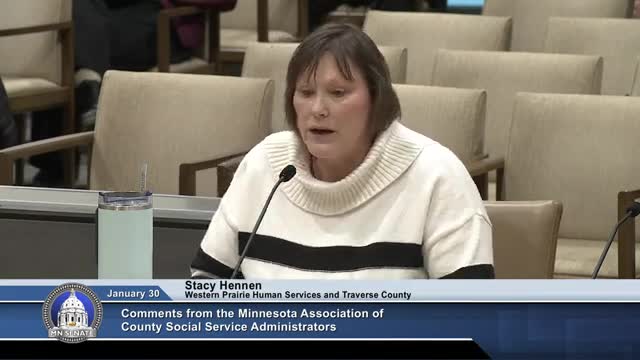Minnesota counties urge legislature to maintain funding for child welfare and family support
January 30, 2025 | 2025 Legislature MN, Minnesota
This article was created by AI summarizing key points discussed. AI makes mistakes, so for full details and context, please refer to the video of the full meeting. Please report any errors so we can fix them. Report an error »

Minnesota's Committee on Health and Human Services convened on January 30, 2025, to address critical issues surrounding child welfare funding and the implications of proposed policy changes. A key focus of the meeting was the potential financial impact on counties if new legislation mandates the preservation of federal benefits for youth in foster care without adequate state reimbursement.
Officials emphasized the importance of maintaining flexibility in funding decisions to support family preservation efforts. They highlighted that counties currently bear significant financial responsibility for child welfare services, including foster care. In 2022, counties received approximately $2.79 million in federal benefits, which directly offset local expenses and helped prevent tax increases. The proposed policy changes could impose unsustainable fiscal strains on counties, potentially leading to service reductions or increased levy rates.
The discussion also underscored the need for a tailored approach to support families, particularly in cases where reunification is possible. Officials noted that a one-size-fits-all policy could hinder their ability to address individual family circumstances, ultimately affecting the stability of children and families involved.
Concerns were raised about the administrative challenges of managing funds for youth who may have short stays in foster care. The complexity of tracking individual savings accounts for fluctuating caseloads could require additional resources and expertise that counties currently lack.
Moreover, the potential unintended consequences of preserving federal benefits were highlighted, particularly for emancipated youth. If these benefits are counted as income, they could disqualify young adults from essential state resources like food and housing assistance, jeopardizing their transition to independence.
The committee urged legislators to consider a comprehensive approach to child welfare financing, advocating for full state funding to offset potential revenue losses for counties. They called for continued case-by-case decision-making to ensure that funds are used effectively for the benefit of children and families.
In conclusion, the committee emphasized the need for robust prevention services to support families and keep children safely in their homes, reducing the overall need for foster care placements. They expressed gratitude for the opportunity to discuss these pressing issues and welcomed further dialogue on sustainable solutions for Minnesota's child welfare system.
Officials emphasized the importance of maintaining flexibility in funding decisions to support family preservation efforts. They highlighted that counties currently bear significant financial responsibility for child welfare services, including foster care. In 2022, counties received approximately $2.79 million in federal benefits, which directly offset local expenses and helped prevent tax increases. The proposed policy changes could impose unsustainable fiscal strains on counties, potentially leading to service reductions or increased levy rates.
The discussion also underscored the need for a tailored approach to support families, particularly in cases where reunification is possible. Officials noted that a one-size-fits-all policy could hinder their ability to address individual family circumstances, ultimately affecting the stability of children and families involved.
Concerns were raised about the administrative challenges of managing funds for youth who may have short stays in foster care. The complexity of tracking individual savings accounts for fluctuating caseloads could require additional resources and expertise that counties currently lack.
Moreover, the potential unintended consequences of preserving federal benefits were highlighted, particularly for emancipated youth. If these benefits are counted as income, they could disqualify young adults from essential state resources like food and housing assistance, jeopardizing their transition to independence.
The committee urged legislators to consider a comprehensive approach to child welfare financing, advocating for full state funding to offset potential revenue losses for counties. They called for continued case-by-case decision-making to ensure that funds are used effectively for the benefit of children and families.
In conclusion, the committee emphasized the need for robust prevention services to support families and keep children safely in their homes, reducing the overall need for foster care placements. They expressed gratitude for the opportunity to discuss these pressing issues and welcomed further dialogue on sustainable solutions for Minnesota's child welfare system.
View full meeting
This article is based on a recent meeting—watch the full video and explore the complete transcript for deeper insights into the discussion.
View full meeting
